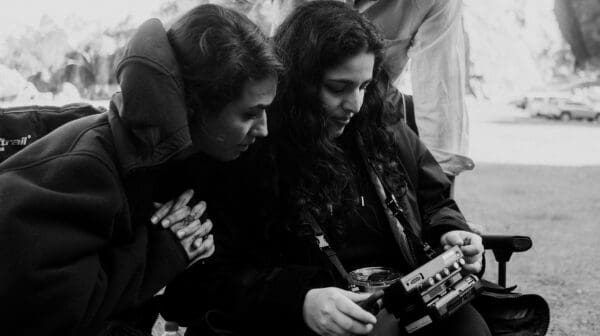
Finding New Spaces Together
‘Vádye Eshgh (The Valley of Love)’ is a collaboration between Second Generation Collective and Abdul-Rahman Abdullah weaving through themes of beauty, diversity and the rebuilding of identity.
The sensationalist stories surrounding Brett Whiteley (1939-1992) have long-captured Australia’s attention. Indeed tales of Whiteley’s outlandish personality often overshadow indepth accounts of the painter’s life and art. Now a new documentary, simply titled Whiteley, is reconsidering the artist’s life beyond his rock star persona. By using previously unseen archival footage and interviews, alongside unpublished correspondence, Whiteley tells the story of the painter’s life using his own words.
Tiarney Miekus spoke to Whiteley director James Bogle about what compelled him to create a documentary on the artist and the personal and artistic importance of Whiteley’s relationship with his wife Wendy. The pair also discuss Whiteley’s complex personality and how Bogle handles the romantic rhetoric surrounding the infamous artist.
Tiarney Miekus: What made you decide to write and direct a documentary on one of Australia’s most well-known and near mythological artists?
James Bogle: It’s because he’s so important and I felt like he wasn’t out there. He wasn’t recognised in the present climate, in the present world. I suppose when checking if people had heard of him before, eight out of 10 people hadn’t. So I thought, wow, it’s time to let people know about this guy. He did so well in the world and when he came back to Australia he brought an international sense of art with him and changed the landscape of the home-front and reinvigorated it.
TM: You’re dealing with a man who clearly has so much ambition and a desire for greatness, but also someone with a very contradictory and complex personality. How do you position Whiteley’s competing dualities and narratives?
JB: Through his art. I think he’s got that style where he can do absolutely crazy art, depending on what’s happening in his life, or he can do really elegant and quite conservative art. I certainly wanted to dig a little bit deeper than the public persona and found once I started making the film with Wendy, we were able to actually access a lot of stills from family photos and letters he used to write. They really brought a completely different side to Brett that the world didn’t really know about. So in terms of his dualities, and his complexities, I felt the further we could reach the better.
TM: You mention Whiteley’s wife Wendy and she’s obviously an important part of Whiteley’s story, both in a romantic and artistic sense. How do you treat that relationship and what was the extent of Wendy’s collaboration in creating the documentary?
JB: Wendy was very collaborative and there’s a whole legacy there that she puts a lot of energy into and has established all sorts of relationships with people throughout the art world. She was our touchstone really.
TM: The documentary is said tell the story of Whiteley “in his own words” using personal letters, notebooks and photographs, as well as reconstructions, animations, interviews and rare footage. What was your process in sorting through the material to achieve the structure and narrative that you did?
JB: Initially I just wanted to dig up everything Brett had said on film, video or audio and then I put that together almost as a rodeo play, to see how it would work. His life is a bit of a hero’s journey really. It’s like a three-act structure where he did a lap of the world and came back to Australia. By the time he came back he was a very changed man. So I just wanted to find if I could actually make the film first person present tense in Brett’s voice, because I thought that would make it a lot more interesting. I didn’t shoot any new interviews at all, but I did record some audio of his sister and of Wendy. Basically I just tried to make the film out of Brett and his voice: through letters to his mother and to Wendy and use all the footage and audio as much as we could.
TM: Whiteley, as we’ve been saying, is always seen as someone who has this larger-than-life persona. Yet at the same time this could also be described as the cliché view we hear of Whiteley. How do you deal with the cliché, as well as the romantic aura of a famous artist?
JB: My sense of what I wanted to do is a tell story of an artist who was driven and so the rock star aspect was something that was part of Brett and he was good at dealing with the media. For me it was about dealing with what was the inner-core and what was actually driving the guy. He had an amazing amount of material where he used to write a lot of letters and out of those letters we got a lot of gold about what kind of guy he was and how everything was effecting him. The rock star part was pretty much once he got back from America and he experienced living with Jimi Hendrix and hanging with Andy Warhol and doing the whole New York thing. So he brought back a sense that he could be like that in Australia and then media just lapped it up, they loved it. So Brett just played that out.
Whiteley is in cinemas from 11 May.
NSW: Chauvel Cinema, Palace Norton St, Dendy Newtown, Dendy Opera Quays, Hayden Orpheum Picture Palace Cremorne, The Ritz Cinema Randwick, Event Cronulla & Event Newcastle
ACT: Palace Electric
VIC: Cinema Nova, Palace Como, Palace Brighton Bay, Palace Balwyn
QLD: Palace Centro, Regal Graceville
WA: Luna Leederville
SA: Palace EastEnd
TAS: State Cinema Hobart